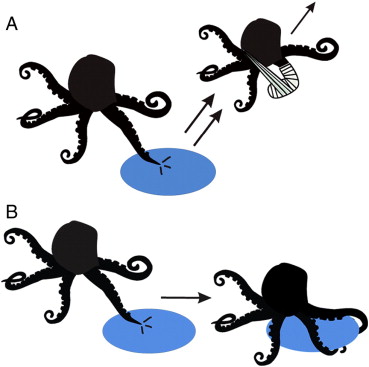I’m working with a student this summer on a project to measure the dynamics of a migrating cell population, and in addition to making pretty pictures and collecting data, we’re going over papers in the scientific literature. One of those papers is about filopodia as sensors.
For those of you who don’t know your cellular anatomy, migrating cells have this kind amoeboid movement in which their cytoplasm oozes in a kind of bulk flow into expanding volumes of membrane, but they also may make long, spindly, delicate ‘antennae’ that reach out in multiple directions. These filamentous processes are called filopodia. Moving cells probe their environment by sending out these little scouts that can sense signals, either repulsive signals that tell the cell to not go that way, or attractive signals that can trigger the cell to flow in a particular direction.
The illustrations in this paper are kind of quirky, but nice. To show how cells respond to signals in the environment, they use an octopus as a stand-in for the cell, with its arms representing filopodia.

Repulsive and attractive interactions in axon pathfinding. A) Repulsive interaction. When the cell contacts the target, the forward momentum of the growth cone is halted. The movement of the veil/lamellipodium resumes at the right or left of the contact site. As a result, the growth cone turns aside. The formation and turnover of FCs within the filopodium are correlated with its behavior during this interaction. B) Attractive interaction. The cell contacts a stationary target and binds tightly to it.
Despite the blatant octopomorphization, something about this appeals to me. I’ve been describing these cells we’re watching as spidery, but clearly I’ve been using the wrong phylum as a metaphor.
I like the bandaged arm image. One of the things we’re sometimes seeing is that cells don’t just retract and limp away, sometimes they literally die and explode into little fragments. This needs an octopoid illustration.


“Despite”
Despite?!!?!!??!!?
What have you done with PZ you impostor?
richardel, check the dumpster outside the University, before raccoons take off with the remains.
Also this overlooks lthe crucial issue: “are the cells squamous and rugose?”
So, cellular-level minesweeper?
Definitely squamous, not particularly rugose.
In A, does the octopus end up with its tentacle in a sling?
Either that (metaphorically) or, as PZ said in the OP,
So they’re not so much spidery as… octopussy?
Your brain cells crawled like that, back when it was forming.
PZ’s brain crawled like an octopus.